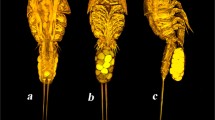Abstract
The normal morphology of the scolopidial organs in pedicels ofChironomus antennae corresponds to that ofAedes, with the following exceptions: (a) The sexual dimorphism of the organ is more pronounced than inAedes. (b) The lumen of the pedicel is larger at its lateral and ventral side than at its median and dorsal side. (c) The construction of the flagellar side than at its median and dorsal side. (c) The construction of the flagellar prongs in male pedicels are directed downwards. The scolopidia of the proximal ring are attached to the upper and lower side of the prongs, 2–4 of the lower scolopidia of each prong have a greater diameter. The number of scolopidia in the proximal ring of females is much less than inAedes. (e) The central organ is identical in both sexes, its scolopidia correspond to type D ofAedes (Boo and Richards 1975 a, b).
Pedicel structures inChironomus anthracinus males parasitized byLimnomermis rosea are identical to those of normal and parasitized females (Table 1). IfC. riparius orC. luridus males are parasitized by the same nematode, pedicels are often intersexual: The degree of the distal depression, construction of the flagellar articulation, number of prongs, and number of scolopidia in the proximal ring may attain all intergrades between maleness and femaleness. The transition between male- and female-like parts of the pedicel is abrupt. The ultramorphology of the scolopidia, however, is not influenced by the parasite.
Zusammenfassung
Der normale Bau der Scolopidialorgane in den Pedicelli der Antennen vonChironomus entspricht dem vonAedes, mit Ausnahme folgender Besonderheiten: a) Der Geschlechtsdimorphismus des Organes ist ausgeprägter als beiAedes. b) Das Pedicelluslumen ist lateral und ventral größer als medial und dorsal. c) Der Bau des Geißelgelenkes ist einfacher, die innere Pedicelluswand massiv. d) Die Spangen des männlichen Pedicellus sind abwärts gebogen, die Scolopidien des proximalen Ringes setzen von oben und unten an den Spangen an, 2–4 der unteren Scolopidien jeder Spange haben größeren Durchmesser. Die Scolopidienzahl im proximalen Ring der ♀ ist viel geringer als beiAedes. e) Das Zentralorgan ist bei beiden Geschlechtern gleich, seine Scolopidien entsprechen Typ D vonAedes (Boo und Richards 1975a, b).
Bei ♂ vonC. anthracinus Zett., die vonLimnomermis rosea Hagm. parasitiert sind, entspricht der Pedicellus völlig dem normaler und parasitierter ♀ (Tabelle 1). Werden ♂ vonC. riparius Meig. oderC. luridus Str. mit dem gleichen Parasiten infiziert, so kann der Pedicellus intersex abgewandelt sein: Der Grad der distalen Einsenkung, der Bau des Flagellum-Pedicellus-Gelenkes, die Spangenzahl und die Scolopidienzahl im proximalen Ring können offenbar alle Zwischenstufen zwischen männlicher und weiblicher Ausprägung erreichen. Der Übergang männchenähnlicher und weibchenähnlicher Bereiche in solchen Pedicelli erscheint abrupt. Die Ultramorphologie der Scolopidien bleibt vom Parasiten unbeeinflußt.
Similar content being viewed by others
References
Aagaard K (1974) Morphological changes caused by nematode parasitism in Tanypodinae (Diptera, Chironomidae). Norsk ent Tisskr 21:11–14
Boo KS, Richards AG (1975a) Fine structure of scolopidia in Johnston's organ of femaleAedes aegypti compared with that of the male. J Insect Physiol 21:1129–1139
Boo KS, Richards AG (1975b) Fine structure of the scolopidia in the Johnston's organ of maleAedes aegypti L. (Diptera: Culicidae). Int J Morphol Embryol 4:549–566
Child CM (1894) Ein bisher wenig bekanntes antennales Sinnesorgan der Insekten mit besonderer Berücksichtigung der Culiciden und Chironomiden. Z wiss Zool 58:475–528
Debauche H (1936) Étude cytologique et comparée de l'organe de Johnston des insectes II. Cellule 45:77–148
Eggers F (1924) Zur Kenntnis der antennalen stiftführenden Sinnesorgane der Insekten. Z Morph Ökol Tiere 2:259–349
Götz P (1964) Der Einfluß unterschiedlicher Befallsbedingungen auf die mermithogene Intersexualität vonChironomus (Dipt.). Z Parasitenkd 24:484–545
Hennig W (1969) Die Stammesgeschichte der Insekten. Kramer Frankfurt a.M.
Mosbacher GC (1973) Die Intersexualität beiLymantria dispar L. (Lepidoptera). Z Morph Ökol Tiere 76:1–96
Rempel JG (1940) Intersexuality in Chironomidae induced by nematode parasitism J exp Zool 84:261–289
Risler H (1953) Das Gehörorgan der Männchen vonAnopheles stephensi Liston (Culicidae). Zool Jb Anat 73:165–186
Risler H (1955) Das Gehörorgan der Männchen vonCulex pipiens L.,Aedes aegypti L. undAnopheles stephensi Liston (Culicidae), eine vergleichend morphologische Untersuchung. Zool Jb Anat 74:478–490
Risler H, Schmidt K (1967) Der Feinbau der Scolopidien im Johntonschen Organ vonAedes aegypti L. Z Naturf 22b:759–762
Römer F (1970) Flugtöne der Weibchen und Locktöne für Männchen vonChironomus plumosus L. beim Schwärmen. Rev Suisse Zool 77:942–959
Schlee D, Glöckner W (1978) Bernstein. Stuttgarter Beiträge zur Naturk Ser C, Nr 8:1–72
Schmidt K (1968) Die Entwicklung der Scolopidien im Johnstonschen Organ vonAedes aegypti während der Puppenphase. Verh Dtsch Zool Ges Heidelberg, Zool Anz Suppl 31:750–762
Schmidt K (1972) Vergleichend morphologische Untersuchungen am Johnstonschen Organ der Insekten. Habilitationsschrift Univ Mainz
Schmidt K (1974) Die Mechanorezeptoren im Pedicellus der Eintagsfliegen (Insecta, Ephemeroptera). Z Morph Ökol Tiere 78:193–220
Thienemann A (1950) Lunzer Chironomiden. Arch Hydrobiol Suppl 18:1–202
Tischner H, Schief A (1955) Fluggeräusch und Schallwahrnehmung beiAedes aegypti L. (Culicidae). Verh Dtsch Zool Ges Tübingen 1954. Zool Anz Suppl 18:444–460
Uga S, Kuwabara M (1965) On the fine structure of the chordotonal sensillum in antenna ofDrosophila melanogaster. J Electron Micr 14:173–181
Wright KA, Jones NO (1965) Some techniques for the orientation and embedding of nematodes for electron microscopy. Nematologica (Leiden) 11:125–130
Wülker W (1958) Parasitäre Intersexualität bei Chironomiden des Schluchsees. Gewässer und Abwässer (Krefeld) H. 20:61–67
Wülker W (1961) Untersuchungen über die Intersexualität der Chironomiden nachParamermis-Infektion. Arch Hydrobiol Suppl 25:127–181
Wülker W (1975) Der Einfluß parasitärer Mermithiden (Nematoda) auf die Fülerimaginalscheiben vonChironomus (Dipt.) Abstract. Verh Dtsch Zool Ges Karlsruhe p 160
Wülker W (1978) Parasitäre Einflüsse auf undifferenzierte Gewebe. Z Parasitenkd 57:255–267
Author information
Authors and Affiliations
Additional information
Herrn Prof. Dr. G. Piekarski zu seinem 70. Geburtstag gewidmet
Rights and permissions
About this article
Cite this article
Schmidt, K., Wülker, W. Parasitäre Intersexualität des Johnstonschen Organes in den Antennen vonChironomus (Dipt.). Z. Parasitenkd. 64, 1–15 (1980). https://doi.org/10.1007/BF00927053
Received:
Issue Date:
DOI: https://doi.org/10.1007/BF00927053




